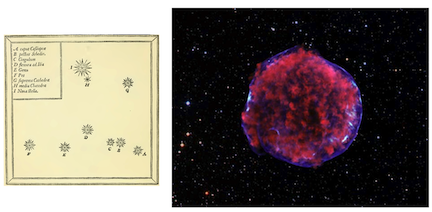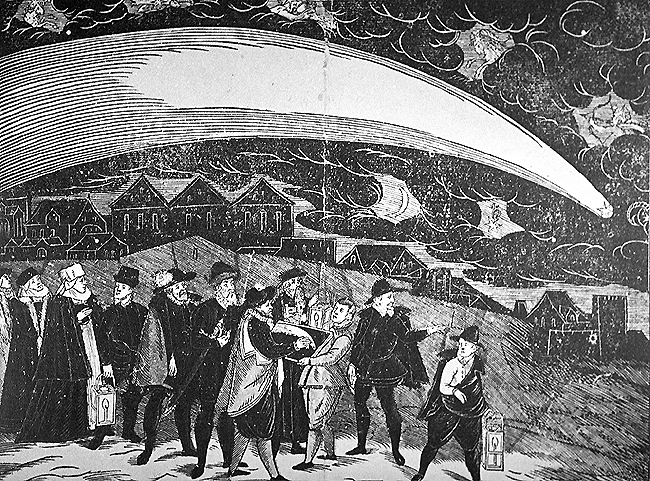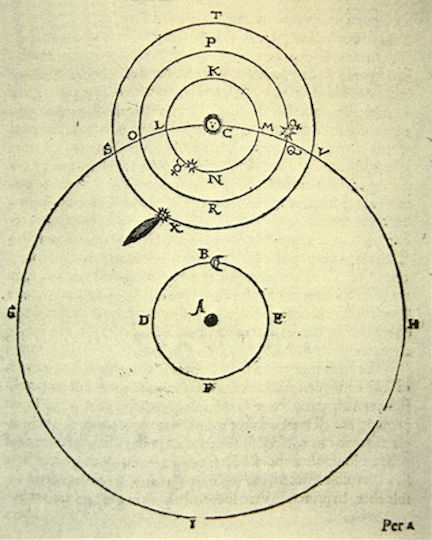9.6. Astronomy, If It Ain’t Baroque, Don’t Fix It: Tycho#
Not much notice was taken of Copernicus’ work. The most dismissive was Martin Luther, as the new Protestantism was literal in Biblical interpretation. Copernicus’ work was taught in a few places, but mostly “after school” by individuals who might lecture on the standard Aristotelian model during the day, but privately instruct students off-hours. One such instructor was Michael Maestlin at the University of Tübingen. He taught Ptolemy and Copernicus and one of his avid pupils was the young Johannes Kepler who became a Copernican as a result. He was studying for the ministry, but his mathematical skills were unusually advanced and upon graduation he was recommended for a position as mathematics instructor Protestant school in Graz, which he accepted.
As we’ve seen, Kepler was an amazing specimen, but physically and emotionally…a wreck…all of his life. He was an extreme Platonist, or even Pythagorean. This means that he believed deeply that the universe was governed by perfect mathematics – that the universe actually is mathematics – and this fit his deeply religious, almost mystical inclinations. His devotion to the curious model of the Platonic solids and their seeming relationship to the planets’ orbits made perfect sense to him. A believer in the reality of math.
He worked for various bigger-than-life people in Germany, Austria, and Czechoslovakia. His first big employer was the very unusual, Tycho Brahe.
9.6.1. The First Laboratory Director: Tycho Brahe#
The Dane Tycho Brahe (1546 - 1601) was, like Copernicus, another nephew of a powerful man who directed his education. However, unlike Copernicus who’s father had died, Tycho’s uncle actually kidnapped him to raise as his own. Tycho was not exactly a shy guy. Yes, the famous nose story is true: he was sent to the University of Copenhagen and as a 20 year old got into an argument over mathematics which led to swords, and he lost the tip of his nose. Because everyone defends mathematics to the death. For his entire life he famously wore a nose made of metal – gold, silver, brass – that he would attach with glue. He’d be talking, his nose would fall off…and he’d reattach it like it was a normal thing. Well there was nothing normal about Tycho. You can just make out this odd attachment in his portrait.
Tycho had become a particularly astute observer of the positions of the stars and planets and even though his uncle wanted a lawyer, he was fascinated by astronomy. His uncle died and then his father, and another uncle helped him to build an astronomical observatory. This family was extraordinarily wealthy.
Recent exhumation and analysis suggests that the nose was brass. Legend suggested precious metals. Oh well.
9.6.2. Shattering the Crystaline Spheres#
On November 11, 1572 he observed a new star in the constellation Cassiopeia. This object was so bright that it would shine during the day, which must have been unnerving. By this point in his development he was an expert observer and by measuring positions carefully he determined that there was no parallax, and that hence this nova stella (new star) was far outside of the Moon’s orbit, and likely with the distant stars. His designation of “new star” is how we get our name “supernovae” and the event that he witnessed, and wrote about in a popular book, is called now Tycho’s Supernova, or in astrophysics-geek-speak: SN 1572. The figure below on the left is from his book, De nova stella.

With this observation the cracks began to form in Aristotle’s model that the planets and stars were firmly attached to real, rotating, crystalline, Earth-centered spheres. Here’s the first problem for Aristotle for which evidence suggested otherwise.
This analysis vaulted Tycho into celebrity status in Europe as a result of his dramatic explanation. The heavens were not permanent! He further observed a comet and showed that it too had to be outside of the Moon’s orbit. One of the absolute certainties in Aristotle’s cosmos was that every celestial object beyond the Moon was permanent. Tycho had demonstrated convincingly that this couldn’t be true since a new star was born, literally before everyone’s eyes.
The King of Sweden, fearing losing him to another country, gave him the island of Hven in Oresund. And built him a laboratory in 1576 that was unlike anything since Alexandria. Tycho inherited not only the land, but the people who lived on the island. Uraniborg was a complete national laboratory. It had more than a hundred lab assistants, carpenters, machinists, gardeners, a police force, a printing office, and the best instruments in the world. And there for the next 23 years, every night, he and his assistants recorded the positions of 1000’s of stars and full orbit positions for all of the planets over two decades. And, he came up with a model of the solar system that was Copernican, but not Copernican.

Pens out!
The next shoe to drop was the Great Comet of 1577. Tycho again made meticulous measurements and found a number of startling things. First, the comet seemed to be related to the Sun—its tail always pointed away from it. Second, it was also clearly outside of the Moon’s orbit among the planets themselves with an apparently varying speed. Somehow this object pierced the crystalline spheres – without any effect in its motion – while following a new circular path. Maybe those fanciful planet-carriers didn’t exist?
“Now it is quite clear to me that there are no solid spheres in the heavens, and those that have been devised by authors to save the appearances, exist only in their imagination, for the purpose of permitting the mind to conceive the motion which the heavenly bodies trace in their courses.”
He had a model.
The cosmos changes and is not perfect.
and the comet observation and measurements show that
Aristotle’s model of crystalline spheres could not be correct.
The Tychonic “System of the World” was a clever way to solve some of the problems that Copernicus’ system also solved. In his picture, shown here:

His thinking was that the Earth is too ponderous to move and so it’s indeed stationary with the Sun and the Moon orbiting around it in a circle. All of the other planets then revolve around the Sun. This way Mercury’s and Venus’ relationship to the Sun was fixed and likewise retrograde motion was also accounted for and the changing brightness of Venus is solved. His objection to Copernicus was both scientific and religious. He was able to determine from measurement that if the Earth were orbiting the Sun that the lack of retrograde motion required the stars to be more than 700 times the distance to Saturn. While a long way, he was not motivated just by the sheer magnitude of that distance, but the fact that the stars appear to have a size and that size could not be so bright if they were that far away. Now of course the stars do have a size, but not that we can see from Earth. Optical effects give the impression that they are extended. Notice how the crystalline sphere idea can’t work in his model. They’d overlap and crush one another.
Tycho’s was a legitimate competitor with the Copernican model until stellar parallax was definitively observed in the 19th century. The Catholic Church loved it as we’ll see. But that wasn’t enough to save Uraniborg. The new King of Denmark would not sustain funding for his lab – which was costing about 1% of the entire national budget – and so Tycho had to move. His entire menagerie, including his pet moose, moved to Prague where he became the Imperial Mathematician to the Holy Roman Emperor, Rudolf II. Yes, the Lutheran Tycho was employed by the Roman Catholic Emperor. Tycho’s moose drank too much beer and died falling down some stairs and Tycho drank too much at a state dinner and because of protocol would not leave the table. Later his bladder burst and he died painfully in 1601. And then a fight broke out.
You might benefit from 7.1_cosmology3_tycho_v2.mp4 for review and wrap-up of these sections.